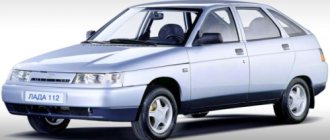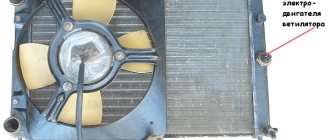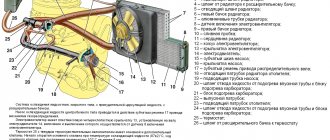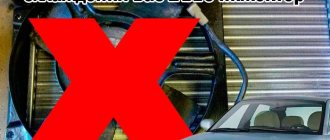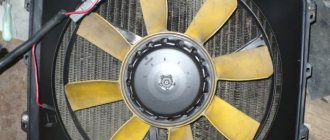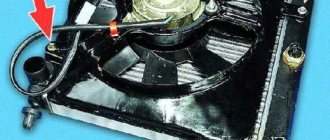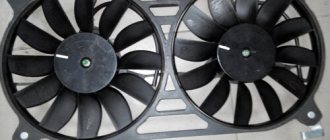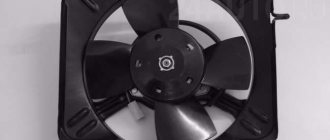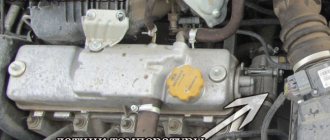Driving for a long time on an overheated engine when the VAZ 2109 injector cooling fan is not working is fraught with serious consequences. The motor may knock or jam, and then major repairs will be necessary. Therefore, if the temperature sensor needle moves steadily into the red zone, immediately turn on the heater at full power, stop in a safe place and let the engine cool. Do not open the expansion tank cap on a hot engine; overheated antifreeze may splash on you.
What to do if the cooling fan on a VAZ-2109 does not work
From the moment electric fans began to be used on VAZs with carburetors, car enthusiasts often began to experience their failure.
Previous mechanical models were considered almost eternal. In most cases, when a VAZ-2109 fan with a carburetor is said to not work, the unit completely stops performing its functions. In this case, the engine temperature exceeds 100 degrees, and the car may fail. To avoid major repairs of the power unit, it is necessary to stop driving after the temperature needle deviates into the red zone. Then you need to find the reason why the fan is not working. You should start checking with the liquid level in the cooling system (check the expansion tank), and then gradually eliminate faults in other parts of the system:
- fuse;
- temperature sensor;
- electric fan motor;
- impeller (it can be deformed, which leads to jamming).
While performing work, you will have to check the condition of the power circuit along the way. All conductors should be visually normal. It is best to eliminate the probable causes of failure one by one so that the system operates stably.
- How to check a fuse
- Checking and replacing the temperature sensor
- Checking and replacing the electric motor
- How to change the impeller or align it
How to check a fuse
This is the simplest part of the test, suitable if the power plant is equipped with a carburetor. You need to find a mounting block in the engine compartment of the VAZ-2109. In it, in place of F-4, there is a fuse responsible for the operation of the cooling fan. Pull it out of its seat, and then use a multitester to take a test measurement (performance test).
If the fuse is working, look for another fault. Otherwise, you need to put a new one in its place marked 16 A and run it in. If the fan is working, you don't need to do anything else. Otherwise, examine other parts of the cooling system.
Checking and replacing the temperature sensor
On a VAZ-2109, the cause of untimely operation or complete failure of the fan is often the coolant temperature sensor. Therefore, it needs to be checked secondarily. The sensor is located at the bottom of the radiator, two wires come from it. Before unscrewing it, you need to accurately check the operation of the cooling system:
- Connect the ends of the wires leading to the sensor together. If after this the fan starts working and the sensor gets hot, then this controller needs to be changed. When testing on a hot radiator, you may find that the sensor body is also warm. In this case, check the thermostat.
- If the fan does not work even after shorting the wires, then the problem may lie in the relay or fuse. The relay should be checked if the sound of its operation is not heard. Depending on the type of car, it may be located in the mounting block (for models with carburetors) or in the passenger compartment under the driver’s storage compartment (for injection cars). The easiest way to check this device is to install a similar device in its place. If after replacing the relay the fan starts working, you don’t have to carry out further testing.
- Sometimes the device does not work, but the sound of the relay operating is present. In this case, check fuse F-8.
If you do not find any faults in other systems, then you need to replace the temperature sensor in the cooling system. This is done according to the instructions:
- Turn off the ignition, remove the terminal from the battery and drain the fluid from the expansion tank and the generator. To do this, you need to remove special plugs.
- Then disconnect the sensor from the terminal block.
- Using a spanner wrench, unscrew the sensor from its place without applying excessive force.
Install a new sensor and reassemble. Some car enthusiasts prefer not to drain the antifreeze from the system, but simply act quickly. In this case, after the sensor leaves the seat, a certain amount of coolant will leave the system, so it will need to be topped up.
Replacing a fan on a VAZ 2109
- — Removal and installation of the fan is carried out only with a cold engine and the “–“ terminal disconnected from the battery.
- — disconnect the block with wires from the fan motor;
- - use a wrench to unscrew the 2 bolts and 2 nuts securing the fan casing;
- - tilt the casing with the fan slightly towards the radiator and remove it from the engine compartment;
- - install the new one in reverse order.
Most experienced car owners assemble a manual switch circuit. fan from the driver's seat, installing an additional toggle switch in the passenger compartment, turn on "beepers" or warning lights in the control circuit.
The health of “Carlson” is the health of the engine!
Checking and replacing the electric motor
If after replacing the sensor the fan still does not work, then it is necessary to check and replace its electric motor. But first you need to dismantle it:
- Remove the negative terminal from the battery.
- Disconnect the fan from the power circuit (one of the blocks is located on its casing).
- Unscrew the mounting screws from the device casing: left and bottom.
- Using a socket with an extension, remove the fasteners connecting the casing to the generator.
- Remove the two nuts on the left to remove the fan pressure spring. Take it off.
- Pull out the entire assembly, along with the housing. Along the way, you may need to disconnect its wires.
Now you need to get to the electric motor and install a new one in its place:
- The electric motor wire is secured to the housing with a clamp; disconnect it.
- Then unscrew the three nuts to remove the motor.
- Inspect the motor seat; all rubber pads on it should be intact and not deformed. If you notice damage, install new gaskets.
- After this, you need to install a new motor in place of the old one and reassemble the fan.
Some car enthusiasts believe that it is possible to repair the engine, but in most cases their attempts do not lead to success.
Instructions for replacing the TOZh sensor with your own hands
Replacing the DTOZH is carried out as follows:
- First you need to turn off the ignition and open the hood of your car.
- Next, you need to place a container under the drain hole of the engine radiator; all the coolant will collect in it. Open the plug and drain the antifreeze, then find the DTOZH and disconnect the connector from it.
- Using a wrench, you will need to dismantle the controller. The device is removed from its installation location. When removing you can see the rubberized seal, when you remove the regulator, do not lose it. If you notice that the rubber band is very worn, it will need to be replaced.
- After this, you will need to install the new controller in the installation location. Using a wrench, screw the device all the way, and then connect the connector with the wire that you disconnected when dismantling. Now all you have to do is pour the working fluid into the radiator device and turn on the ignition, start the engine and check the operation of the device.
How to change the impeller or align it
If, after dismantling the fan, you notice that the impeller is damaged or uneven, you need to remove it:
- There is a lock washer in the center of the impeller; pry it up with a flathead screwdriver and remove it. If there is an additional fastening in the form of a nut, unscrew it.
- Remove the impeller and inspect it. If there is any deformation, it is best to install another impeller.
During this work, you can upgrade the fan by installing an impeller with 8 blades instead of the standard 4.
Examination
On VAZ 2109 engines, the operating temperature is 90 degrees.
If the indicator needle crosses the 100 degree mark, the car should be stopped immediately, the engine should be turned off and the power unit should cool down. Without doing this, you risk major, expensive engine repairs.
The motor can overheat for various reasons:
- The thermostat has failed;
- The radiator is clogged;
- The radiator fan has failed;
- The fan switch sensor is broken;
- The coolant level in the system has dropped;
- The pump has failed;
- The integrity of the wiring in the fan circuit has been compromised.
All these reasons can and should be checked before purchasing new parts.
Here is an example of checking a fan and sensor.
Object to be checked
Method
Take one wire about a meter long. Preferably with two crocodiles at the ends. The mass goes to the fan. Your task is to supply voltage directly from the battery to the fan. Apply 12 volts to the second contact of the fan. If he's spinning, he's fine. If not, you'll have to change it
Turning on the ignition, close the sensor contacts with a screwdriver. Normally, when it is closed, the fan should start spinning, and if it is open, it should stop. Please note that different types of sensors have a certain response temperature - from 87 to 90 degrees or more
Methods for checking DTOZH
How to check the TOZ index on your own? To do this, you can use one of several methods; diagnostics are performed using a multimeter.
- First, the negative probe of the tester should be connected to the cylinder head, and then activate the ignition by turning the key in the lock.
- Then, using a multimeter, you need to determine exactly what voltage appears at the output.
- If the controller is working, then the value of this parameter should be at least 12 volts, of course, if the battery is fully charged. If the diagnostics showed that the obtained values were lower, then you need to do repairs or change the regulator (the author of the video about diagnostics is the Mechanical Technician channel).
Sensor
Don't rush to change the fan right away. Often the problem was a sensor, relay, fuses, or simply broken wiring. First of all, we will check the sensor and also tell you about the features of replacing it.
The fan switch sensor is located at the bottom of the radiator. A couple of wires come off it.
Searched device
Accurate check
In order not to rush to conclusions, experts first advise checking the sensor for functionality.
- If the fan does not want to turn on according to the standard circuit, try shorting the wires that go to the sensor. If the fan is running and the sensor is hot, the problem lies there. If the radiator is hot during testing, the sensor housing may be warm. This suggests that you should check the condition of the thermostat and the coolant level in the tank. You may need to change and top up accordingly.
- If, after closing the wires, the fan does not turn on, the sound of the relay being activated is not observed, check the condition of the relay and fuse. It is number 4 in the mounting block.
- By shorting the wires, the fan did not start, but the relay worked. Here you should check fuse number 8.
- If the fan starts randomly on a cold engine, it does not turn off for a long time, try disconnecting one wire from the sensor. If the fan stops, the sensor contacts are stuck. If the fan continues to turn, sticking has occurred on the contacts of the control relay.
Having discovered that the regulator has failed, there is nothing left to do but change the radiator fan activation sensor.
Replacing the sensor
Changing the sensor is quite simple:
- Turn off the ignition;
- Drain the coolant from the expansion tank;
- Disconnect a pair of wires from the sensor terminal block;
- Using a 30 mm wrench, unscrew the regulator from its seat. You shouldn’t apply a lot of force; you risk breaking the seat;
- Following the reverse sequence, install the new sensor.
Disabling the sensor
You can change the sensor without draining the coolant. To do this, you need to quickly unscrew the old regulator and screw in a new one in its place. A small part of the coolant will spill out, but you won’t have to drain it for a long time and then pour it back in.
Fan
If the problem lies in the injector or carburetor cooling fan, then you will have to remove it. It is quite possible to repair the unit by replacing the electric motor or impeller.
Diagram with casing, radiator, fan and impeller
To remove the valve, perform the following operations:
- Disconnect the negative terminal from the battery;
- Disconnect the wire terminals. One of them is mounted on the fan casing;
- Take a wrench and unscrew a couple of connecting bolts. They fix the vent casing on the left tank;
- Next, unscrew another lower nut holding the device casing;
- Now you will need a socket extension to unscrew the right nut on top that secures the vent housing to the radiator;
- All that remains is to unscrew the fan pressure plate. To do this, remove the pair of left nuts;
- Remove the pressure plate by hand;
- Now remove the fan along with the casing.
You have removed the unit. Now you have a choice - change the entire unit, or try to repair it by replacing the electric motor or impeller if they are damaged.
Replacing the electric motor
- Disconnect the fan motor wire that is held in place by a clamp on the casing.
- The electric motor is held on the casing by three nuts. They all need to be unscrewed.
- Remove the electric motor from the fan housing.
- Be sure to check the condition of the rubber bushings of the electric motor, which will remain on the casing. If cracks or signs of deformation are detected, they must be replaced.
- Check the electric motor for functionality. If it fails, you can purchase a new one and insert it into the old casing.
Electric motor
It is not uncommon that the performance of a radiator fan is impaired due to a deformed impeller. By replacing it, you can restore functionality to the device.
Replacing the impeller
To change the impeller, follow the instructions:
- Pry up the lock washer using a flathead screwdriver. It is located directly in the center of the impeller;
- Lift the washer and remove it;
- In some cases, the impeller is secured to the fan motor with a nut. Therefore, if you have one, unscrew the mount;
- Remove the impeller and assess its condition. If it is worn out or deformed, replace it with a new one;
- Many people, instead of a standard 4-blade impeller, install a more advanced 8-blade impeller.
Changing the impeller
During reassembly, make sure that the motor pin fits into the longitudinal hole on the impeller, as shown in the figure below.
Direct the pin into the longitudinal hole
Modernization
If you want to improve the operation of your radiator fan on the VAZ 2109, we offer the appropriate instructions.
To upgrade, you will need to install a second sensor and modify the system somewhat.
- The standard power sensor will be responsible for the operation of the fan at maximum speed.
- An additional sensor will include a reduced speed. It is installed at the top of the cooling system.
Now let’s talk more specifically about how to organize all this.
- Take a temperature sensor whose response temperature is similar to the standard regulator.
- Install it in the upper pipe fitting to the radiator.
- To mount the element, you will need a pair of washers and a nut. Be sure to lubricate the washer with sealant to prevent leakage from the installation hole.
- Buy a resistor to install on the stove fan. It has several outputs, so if desired, you can make several operating speeds.
- It is necessary to make an additional control circuit. Through it, less voltage will be supplied to the motor winding.
- The temperature sensor located in the upper part of the cooling system is responsible for turning it on.
- It is better to do control not by plus, but by weight.
- The system will work through a button in the cabin. To the left of the dashboard there is a grille with two plugs. Cut out one of them and set it to turn off on two modes. You can take the heater switch from a VAZ 2107.
- In the first position the low frequency will be switched on, and in the second – the maximum speed.
- One common wire is fed to the minus.
Such modernization is not provided for by the design of the VAZ 2109. These are modifications made by car enthusiasts. Therefore, installing a second sensor is entirely your personal responsibility.
The fan is an important component of the cooling system of VAZ 2109 injection and carburetor engines. If you wish and have time, you can easily replace or repair it yourself.
The radiator cooling fan does not turn on - reasons, troubleshooting
Problems with the cooling fan usually occur in used cars with decent mileage. This breakdown manifests itself in different ways; the fan may not work stably, may turn on late or not turn on at all. Today we will talk about the last fault, that is, the situation when the cooling fan does not turn on at a certain moment. You will learn about why this happens, where to look for the reason, and also in what sequence. Let’s take the “nine” as an example, but the method and reasons will be almost the same for all VAZ models.
Finding a breakdown is not so much labor-intensive as it is comprehensive, since there can be quite a few reasons why the fan does not turn on, from a banal fuse blown to more complex problems associated with a malfunctioning thermostat or problems with the electrical wiring of the vehicle’s on-board network.
If the engine boils, but the fan still does not turn on, then the first thing that comes to mind for most motorists is problems with the fan wiring. However, very often the wiring has nothing to do with it, and the real reason lies precisely in the thermostat. The device designed to monitor the temperature of the coolant (coolant) may fail or simply jam, after which the coolant stops circulating through the radiator, as a result, the radiator sensor does not work, and the fan itself does not turn on. Read this article on how to check the thermostat.
Possible malfunctions and ways to eliminate them
For what reasons may the device stop functioning:
- Internal damage to the contact located inside the device. In practice, as a result of prolonged use, this contact may break, and intensive use of the DTOZH may lead to the appearance of cracks on it. If the reason lies in a break, then this is fraught with complete breakdown of the controller; the sensor will simply burn out. If the problem is cracks, then the device may work, but not correctly. Due to the lack of contact, the controller will transmit incorrect information about the liquid, that is, incorrect values will be displayed on the instrument panel.
- Another reason is damage to the insulation of the device. If the device insulation is broken, the controller may operate with short circuits. Short circuits in its operation can cause complete failure of the device.
- There is a break in the electrical circuit near the controller. Due to damaged wiring, the device will not be able to transmit antifreeze data to the dashboard. Accordingly, if the engine overheats, the driver may not even know about it.
What symptoms can you use to determine if this device is not working:
- The car engine became difficult to start when hot. That is, you can start it in the morning, but when the unit warms up, problems appear.
- Increased fuel consumption. You can only identify such a sign when you carefully monitor the car’s performance. The increased fuel consumption is due to overload of the power unit when it is warmed up.
- If the DTOZH breaks down and no longer functions, then the control panel will display incorrect data on the engine temperature. It usually takes no more than 10 minutes to fully warm up the internal combustion engine. If 10 minutes after starting you notice that the arrow on the indicator on the dashboard has not gone up, then most likely the DTOZH needs to be changed (video shot by Dmitry Yakovlev).
Radiator fan of VAZ 2109 Injector does not work
If the VAZ 2109 fan does not work
Driving for a long time on an overheated engine when the VAZ 2109 injector cooling fan is not working can cause serious damage. The engine may cause other damage, in which case it will require major repairs. Therefore, if the temperature gauge needle constantly moves into the red zone, immediately turn on the heater at full power, stop in a safe place and allow the engine to cool. Do not open the expansion tank cap on a hot engine; it can be sprayed with superheated antifreeze.
VAZ 2109 cooling system
VAZ Liquid engine cooling system 2109 The nozzle is a closed type system with forced circulation of antifreeze (coolant). The system consists of the following blocks:
- water pump with impeller driven by a timing belt;
- a thermostat that directs coolant to a small, in other words, a large circle, depending on the degree of engine warm-up;
- a radiator consisting of two plastic containers for coolant flow and aluminum heat pipes located in the front of the engine compartment to facilitate air access;
- expansion tank with inlet and outlet valves to maintain standard pressure in the system;
- fan
in front of the radiator for efficient heat dissipation.
The VAZ 2109 carburetor fan does not work.
Running the fan is critical in the heat of the year when you're moving slowly in traffic. Under these conditions, overheating of the engine is especially possible and, therefore, good fan operation is necessary. The cooling air flow must be properly directed to the radiator
. If the VAZ 2109 injector cooling fan does not work, the cooling system may boil.
Fan control
If the car is a VAZ 2109
If the engine has separate injection and injector, then there is no common touch switch for carburetor model owners. The ECU fan controller turns the fan on and off. This controller receives information from a coolant temperature (DTO) sensor located in the exhaust pipe between the thermostat and the cylinder head. The sensor is used to control not only the fan, but also the motor. Including:
- optimization of the degree of enrichment of the air-fuel mixture: in a cold engine the mixture is enriched again, and when heated, it is depleted;
- increasing the crankshaft speed when starting the engine so that the engine does not lag immediately after starting;
- setting ignition timing to ensure fuel economy;
- holding the recirculation valve in the closed position until the engine is in running mode.
Why doesn't the engine cooling fan work in 2114?
VAZ 2109 fan, fan fan, does not work.
fan
cooling
radiator
.
To determine the temperature of the VAZ VAZ 2109 , a thermistor is used in the injector. a resistor whose resistance depends on temperature. VAZ 2109. A thermistor with a negative temperature coefficient is used. This means that as the temperature increases, its resistance decreases.
Voltage is applied to the thermistor; By changing it, the sensor determines the temperature of the coolant and transmits it to the computer. And this device already turns the radiator fan on and off.
Fan diagnostics
To test the device, you will need a 1.5-meter wire, preferably with crocodile clips at the ends. With the engine off, connect the positive terminal of the battery directly to the fan terminal. The working unit should begin to rotate. Startup error is faulty. If the engine does not start when the engine fan
Although the diagnosis indicates that they are in good condition, they should be tested for DTH.
During the test, you will need an ohmmeter to measure the resistance of the sensor. An ohmmeter is part of any, even the simplest, portable digital multimeter. The procedure looks like this:
- With the engine cold, remove the wires from the DTO terminals.
- Set the multimeter mode switch to the “resistance measurement” position.
- Measure the sensor resistance. At room temperature it should be approximately 2200-2800 Ohms.
- Replace sensor wires.
- Start the engine and let it idle at about 80 degrees Celsius.
- Turn off the engine. Remove the wires from the sensor contacts.
- Measure the sensor resistance. At 80 degrees the resistance should be in the range of 270.389 ohms.
Fan diagnostics
In order to check the operation of the unit, you will need a one and a half meter wire, preferably with “crocodiles” at the ends. With the engine off, connect a wire from the plus terminal of the battery to the fan contact directly. A working unit should begin to rotate. If it doesn't start, it's faulty. If the cooling fan does not turn on when the engine overheats, although diagnostics indicate that they are working properly, you should check the DTOZH.
When testing, you will need an ohmmeter to measure the resistance of the sensor. An ohmmeter is included in any, even the simplest portable digital multimeter. The procedure is as follows:
- With the cold engine turned off, remove the wires from the DTOZh contacts.
- Set the multimeter mode switch to the “resistance measurement” position.
- Measure the sensor resistance. At room temperature it should be approximately 2,200 - 2,800 ohms.
- Reinstall the sensor wires.
- Start the engine and let it warm up at idle speed to about 80 degrees.
- Turn off the engine. Remove the wires from the sensor contacts.
- Measure the sensor resistance. At 80 degrees, the resistance should be in the range of 270 - 389 Ohms.
If for some reason the sensor resistance does not meet the standard, the part must be changed. And if it does, but the unit does not turn on, something is not working in the electronic engine control unit. This should be addressed to a service station. To diagnose and flash the ECU, you need special equipment.
Why the fan does not work - VAZ 2109
Two fans are installed on the VAZ-2109 car . The first, more powerful, is installed in the engine cooling in order to increase air flow through the radiator core. The second fan is installed in front of the heater radiator (“stove”) , its task is to pump heated or unheated air inside the car. Both fans are driven by DC motors.
The fan, which is installed in the hole in the casing covering the radiator core in the electrical circuit for its connection, has a sensor for automatically turning on the electric motor. This sensor is screwed into a threaded hole located in the right radiator tank, since there will be the highest coolant temperature after the thermostat is activated. The fan starts working without driver intervention. The sensor should be triggered when the operating temperature of the antifreeze exceeds 90-95 degrees and send a signal to the electric motor switching relay located in the mounting block. The electrical circuit for switching on the electric motor is protected by fuse No. 4 and No. 8 on mounting blocks of type 17. 3722.
If your VAZ-2109 car is equipped with a mounting block of type 2114-3722010-60, then the fan electric motor is switched on directly from the switch-on sensor, without the participation of a relay. It's just not in the mounting block at all. The electrical circuit is protected by a fuse designated No. 5. In the event of any malfunction in these electrical circuits, the fan will not turn on. The driver will determine this by reading the coolant temperature gauge. The arrow of this indicator will go to the red zone of the scale. In this case, it is necessary to reduce the load on the engine to idle speed, turn on the interior heater fan and open the tap to supply coolant to the heater radiator, start coasting until it comes to a complete stop, to eliminate the causes of the malfunction.
It is necessary to start looking for the cause of malfunctions from motor activation sensor . To do this, open the hood and disconnect the terminal from the sensor. To further check the sensor, you will need a piece of wire, with which you need to short-circuit the two wires suitable for the terminal. Wrap the jumper with electrical tape so that it does not touch the ground of the car. Turn on the ignition, and if everything else is correct, the fan will start working. Moreover, in this case it will work continuously as long as the ignition is on.
If the fan on the VAZ 2109 does not work, then open the cover of the mounting block and check the serviceability of fuses No. 5 on block 2114-3722010-60 and No. 4, No. 8 on block 17. 3722. Look for the fuse number marking on the top of the cover. After making sure that the fuses are in good condition and provided that the fan still does not work, you need to check its electric motor.
To do this, you will need two insulated wires to connect the fan motor terminals directly to the battery. If the fan starts working, make sure that the air flow goes under the hood of the car, and not vice versa. If the connection is incorrect, change the polarity of the wires connected to the battery. When troubleshooting, you can thus get to the repair site, and you can turn off the fan motor only by disconnecting the wires from the battery. In this case, the reason that the fan did not turn on would be either a faulty relay or a faulty wiring.
In order for the driver not to be left alone with such malfunctions, he needs to have in the trunk of his car a coil of car wires three meters long and a supply of fuses , which are located in the mounting block.
Description of DTOZH and DVV
Where is the coolant temperature and fan activation sensor located in 2109 with an injector or carburetor engine, what should I do if the device does not work? First, let's look at the basic questions regarding the purpose, device and principle of operation.
Purpose and functions
The main purpose of the DVV is to activate and deactivate the ventilation device on the engine radiator in order to cool the power unit. The device turns the fan on and off based on the temperature of the liquid in the cooling system. On injection machines, this is DTOZH; turning the fan on and off is controlled by the brain according to the readings of this sensor.
As for the TOZh controller in the VAZ 21093, this device is intended to display readings about the antifreeze temperature on the car’s dashboard in the cabin. With its help, the driver can find out about possible overheating of the power unit.
Location
As for the location, in models 2108, 2109 and 21099 the DTOZH is located between the engine cylinder head and the thermostat, in particular, on the intake hose. The DVV is installed in the threaded hole of the expansion tank with coolant. If you look in the direction of travel of the car, the refrigerant container is installed on the right.
Principle of operation
First, let's look at the operating principle of the antifreeze temperature controller. This device is a thermistor-resistor that operates with a negative coefficient. The amount of resistance in this case can be measured as a result of a decrease or increase in the temperature range. When the car engine heats up, the resistance on the device decreases, and when the power unit cools down, this value increases. For example, when the engine is fully warmed up, the resistance value on the device is 180 Ohms, and at low negative temperatures (-40 degrees) this figure will increase to 100,700 Ohms.
When the driver activates the ignition by turning the key in the lock, the control module (ECU) begins to supply voltage to the controller using a resistor. The DTOZH itself, as mentioned above, is a thermistor; accordingly, the incoming voltage will change in accordance with the temperature of the liquid. When this value decreases, the control module analyzes this, according to which the required volume of fuel for injection into the cylinders is determined. As the car engine warms up, the volume of fuel used for injection will drop.
As for the DVV, it is installed in the negative cable gap, which is connected to the ventilator activation relay in the fuse box. When the temperature value increases to 99 degrees, a short circuit occurs at the controller contacts due to the bimetallic plate. As a result, the current through the device flows to a relay located in the block, from where it is supplied to the electric motor of the device on the fan, ultimately activating the latter (author of the video channel AndRamons).
In “Nines” produced after 1998 and equipped with safety blocks from the VAZ 2114, there is no relay in this section of the circuit. Therefore, the regulator itself is also mounted in the gap of the negative cable, but only the one that is connected directly to the fan. In this case, the closure occurs at a similar temperature. If the antifreeze cools, the plate opens the contacts, causing the electric motor to turn off.
